
Learn more about Extract PBA by downloading the Extract PBA product booklet.

Learn more about Extract PBA by downloading the Extract PBA product booklet.
Growers know that uniform corn emergence is a must for achieving great yields. Recent research shows that a delay in emergence of just 12 to 14 hours can affect yield potential.
In side by side field trials at three different locations led by North Carolina State University cropping systems specialist Dr. Ron Heiniger, an in-furrow application of Accomplish LM promoted uniform corn emergence, increased row and kernel number, and increased ear weight by 1/8 lb compared to check (10-27-0 applied in a 2x2 band). Uniform emergence was associated with higher yields: Accomplish LM increased the average yield by +11.5 bushels per acre.
Accomplish LM is a nutrient use efficiency product that offers concentrated biochemistry tin an easy-to-handle liquid form. Formulated for broadcast and starter fertilizer applications, it helps growers get the most out of their crop fertility programs by increasing nutrient availability and uptake and by promoting root growth and development.
Use Accomplish LM this spring for more uniform crop emergence and the potential for higher yields at harvest.
Interested in more information on Accomplish LM in corn starter programs? Read our starter booklet.
By Maud Hinchee, PhD, Chief Science Officer, Agricen Sciences
 Plants are constantly responding to their senses. They can touch, smell, taste and otherwise sense water, food and predators—and they can remember. Of course, they don’t do all of this exactly the way a human does, but they do respond to the messages they receive from the world around them to survive, thrive and reproduce—much the way we do.
Plants are constantly responding to their senses. They can touch, smell, taste and otherwise sense water, food and predators—and they can remember. Of course, they don’t do all of this exactly the way a human does, but they do respond to the messages they receive from the world around them to survive, thrive and reproduce—much the way we do.
This is a pretty stimulating idea – that plants are actually sentient beings responding to stimuli in a purposeful manner and communicating with each other and with potential friends and foes. (For more on this, take a look at the “What Plants Talk About” episode from the PBS series, Nature.) It’s also an idea that has captivated researchers and companies in the agricultural space in recent years, most notably around the topic of biostimulants and other agricultural biologicals.
Biostimulants are any of a variety of naturally-derived products that signal plants through biochemical messages to improve their growth, health and nutritional value. Biostimulant products include humic and fulvic acids, seaweed extracts, protein hydrolysates, amino acids, microbial inoculants and biochemical products like Agricen’s, which are derived from naturally occurring microbial communities.
Typically, such products are organically complex, and we haven’t always immediately understood the way they work to influence plant growth and health. What we do know, however, is that they can have a positive effect on plants in the agricultural setting, a claim that is supported by significant and growing scientific evidence.
Biostimulants affect a variety of physiological and biochemical pathways in plants – influencing changes in plant behaviors such as increasing root growth, enhancing nutrient uptake and improving stress tolerance. Essentially, they provide a way to communicate with plants and “tip them off” on how to positively adjust to the environmental and biotic challenges typical of agricultural systems.
We are just beginning to comprehend the significant potential of these products. It will continue to be both exciting and challenging to explore the possibilities biostimulants offer as we work to increase agricultural production for future generations.
Learn more about biological products for agriculture:
 Brandon Burkhart is a fourth-generation farmer from Oto, Iowa. Varying soils on his family's 2500-acre corn and soybean operation used to mean it was difficult to get a good, efficient use out of their applied nutrients. Today, Brandon and his family use ACCOMPLISH and TITAN to maximize their fertilizer efficiency, with excellent returns from the accompanying gains in yield.
Brandon Burkhart is a fourth-generation farmer from Oto, Iowa. Varying soils on his family's 2500-acre corn and soybean operation used to mean it was difficult to get a good, efficient use out of their applied nutrients. Today, Brandon and his family use ACCOMPLISH and TITAN to maximize their fertilizer efficiency, with excellent returns from the accompanying gains in yield.
“When using our ACCOMPLISH and TITAN combination on corn, it’s been [a yield increase] upwards of 10 bushels or more,” says Brandon. “On our bean operations with just TITAN, we’ve seen jumps of 10 bushels per acre.”
“It’s been a great investment for us. It’s been a great return on investment also.”
Watch the video to see how ACCOMPLISH and TITAN are paying off for Brandon and his family.
After every harvest, valuable nutrients remain in the crop residue on the ground. How can growers access the nutrients in this season's residue to feed next season's crop?
Extract Powered by Accomplish™ helps growers more easily manage residue while releasing valuable nutrients for next season's crop. Use Extract PBA with fall or spring burndown to continue to take advantage of the nutrients that were applied during the previous growing season. Learn more by watching this short video.
Watch the Video:
EXTRACT Powered by Accomplish™ (EXTRACT PBA), a new product manufactured by Agricen for nutrient release from crop residues, is now available from Loveland Products.
Labeled for residue management and pre-emerge applications, EXTRACT (6-0-0) allows soybean, corn and other row crop growers to access the full nutrient potential of their crop residues by:
EXTRACT combines the powerful biochemistry of ACCOMPLISH® LM with ammonium thiosulfate (ATS). When applied on crop residues, the ACCOMPLISH biochemistry accelerates residue decomposition and speeds nutrient release, while ATS promotes an optimal carbon to nitrogen ratio to enhance soil microbial activity, further expediting nutrient return to the soil profile.
By using EXTRACT to release valuable nutrients from crop residues and add them back into the soil profile, growers can re-utilize some of their previous fertilizer investments—those that were taken up by the plant and remain in the residue after harvest—for next season's crop.
Learn more by downloading the EXTRACT product booklet.
Farming corn and soybeans in Breda, Iowa, Cory Uhlenkamp and his family use Accomplish LM on every acre to help with soil health and crop productivity.

“Yield-wise I’d say we’re getting at least 10 bushels [increase per acre] or better,” says Cory.
“We only use products that we truly do believe work. Accomplish LM is one of those products that we’ve added to our normal lineup,” he adds. “It’s a product that every year, year in and year out, you can always count on.”
Hear more of what Cory has to say about Accomplish LM.
Watch the Video:
This year, many parts of the country dealt with above-average to excessive spring rains. Wet conditions set the stage for denitrification (converting nitrogen in the soil system into N2 gas) and nitrate leaching, which may explain some of the yellowing growers have observed in fields where there has been a lot of moisture.
Starter fertilizer use can help to overcome some of this nitrogen loss by adding nitrogen back into the system. Other crop inputs can also pay off. Accomplish LM can be used in a starter blend to ensure that more of the applied nitrogen or nitrogen in the soil system is in a form that is readily available for plant uptake.
In the field trials we’ve seen this season, the difference between starter and no starter was very obvious. Starter applications that included Accomplish LM have been giving a very strong performance, as seen in these corn trials from Wheatland, Indiana.
Corn - Wheatland, Indiana (2015)
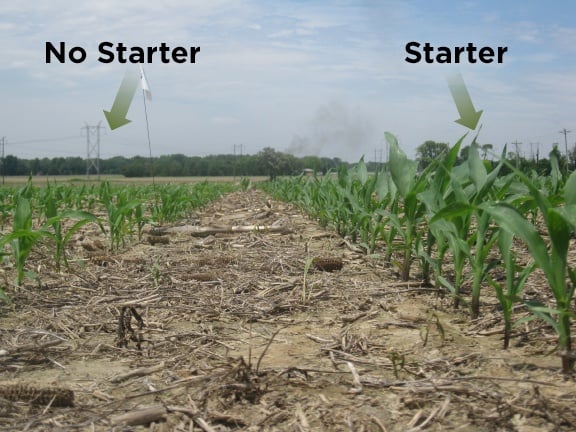
Starter vs. no starter fertilizer; Photo taken May 27, 2015
Corn - Wheatland, IN (2015)
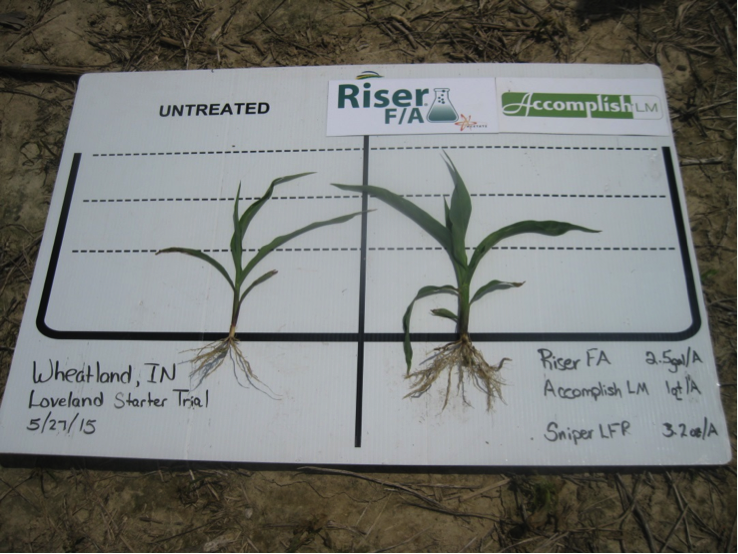
Accomplish LM applied at 1 qt/acre; RiseR FA applied at 2.5 gals/acre; Sniper LFR applied at 3.2 oz/acre
Corn - Wheatland, IN (2015)
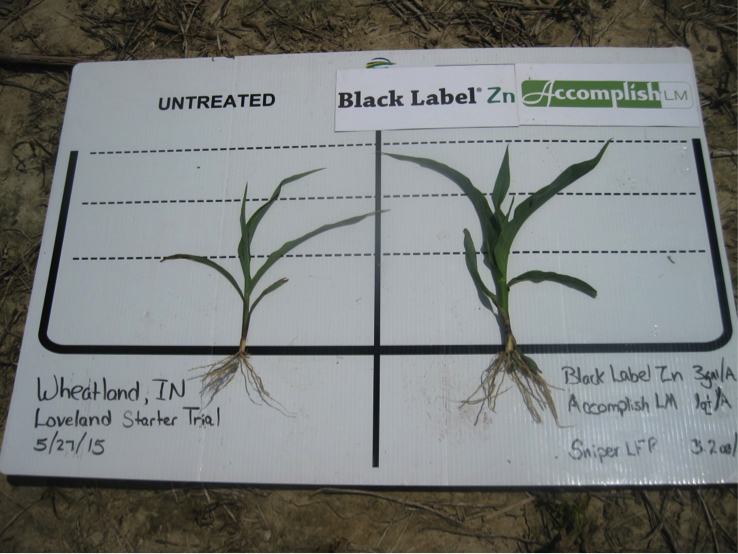
Accomplish LM applied at 1 qt/acre; Black Label Zn applied at 3 gals/acre; Sniper LFR applied at 3.2 oz/acre
Learn more about starter fertilizers and how Accomplish LM can enhance corn starter programs. Download “Improving Crop Yields with Starter Fertilizers.”
Norman McPherson and M.H. Bitely are growers in Grady, Arkansas, who incorporated both Accomplish LM and Titan PBA into their fertility program for this year’s corn. Both growers applied Titan PBA on their dry fertilizer in the fall, and included Accomplish LM with their standard liquid starter fertilizers at planting.
The results so far are impressive.

Growers Norman McPherson and M.H. Bitely in Grady, Arkansas.
In fields where Accomplish LM and Titan PBA were added to the standard fertility program, corn had much smaller dents compared to corn from a nearby field they farm where Accomplish LM and Titan PBA weren’t used.
Smaller dents will add up to a lot more yield, says Norman.
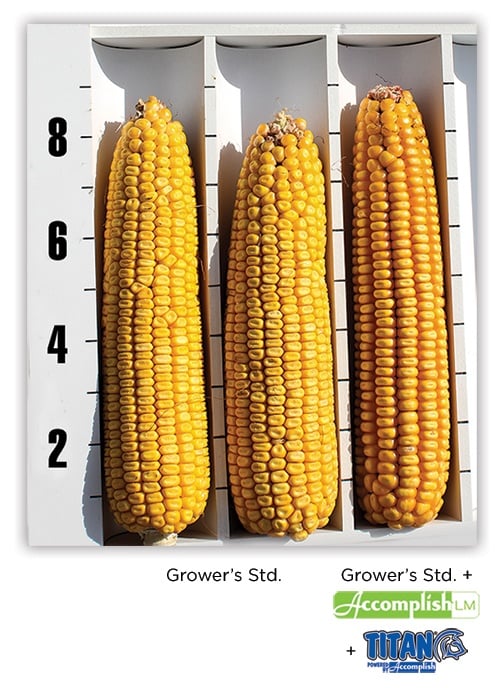
With Accomplish LM and Titan PBA, corn ears show less denting.
Root digs reveal that the addition of Accomplish LM and Titan PBA also leads to significant improvements in root mass.
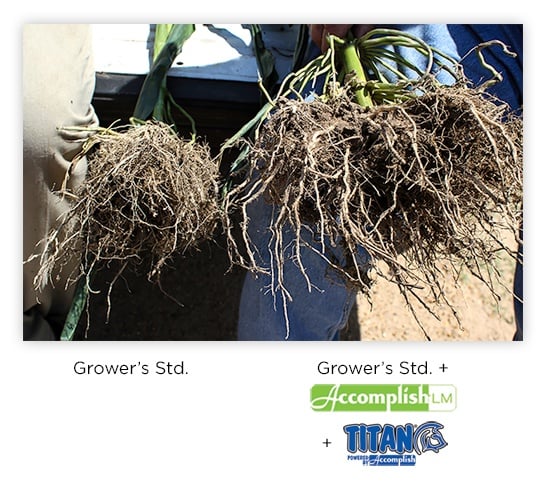
Significant gains in root mass with Accomplish LM and Titan PBA.
From these mid-season results, we expect to continue to see great things, as we have seen in other trials incorporating both Accomplish LM and Titan PBA into fertility programs on corn, soybeans, rice, and wheat.
We’ll follow up again with Norman and M.H. later in the season to share more details about their crops’ performance.
Soybean Startup is a tank mix of Accomplish® MAX and Radiate® applied in-furrow at planting. The goal is to get soybean plants off to a better, faster start and enhance productivity. In trial after trial, this program keeps giving a standout performance in the field.
The soybean plants in the pictures below were planted on May 28th, 2015 in Greensburg, Kansas, by a grower who had trialed the Soybean Startup program on half of his acres. The beans on the left were treated 2x2 with 10 gallons of 16-0-16-5 alone, while the beans on the right were treated 2x2 with 10 gallons of 16-0-16-5 and plus the Soybean Startup in furrow. Pictures were taken mid-June.
With Soybean Startup, the plants are bigger and healthier, and they have larger, better developed root systems compared to untreated plants.
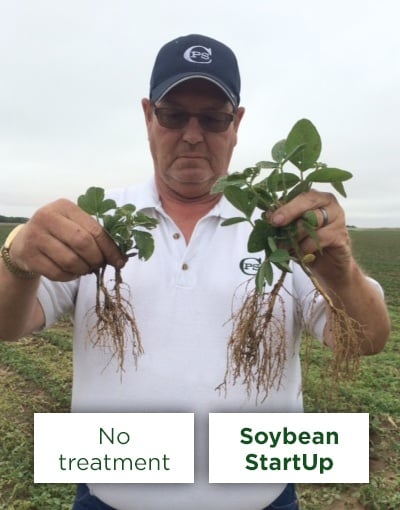
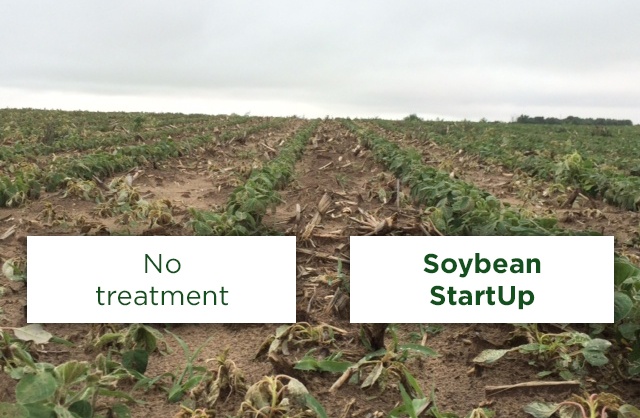
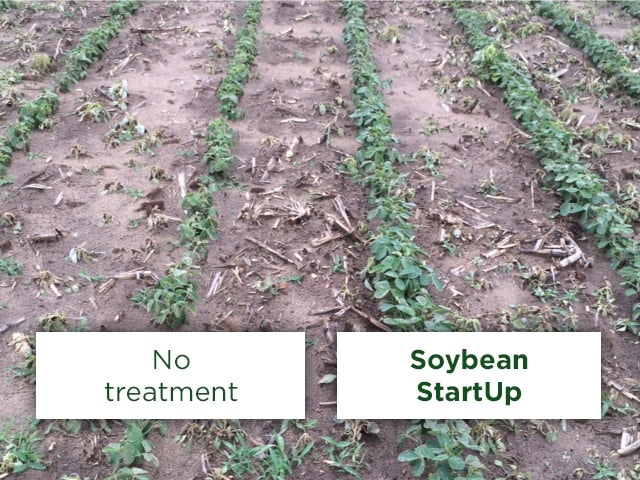
After seeing the difference between the treated and untreated soybeans, the grower of these beans is now going to use a Soybean Startup program on all of his double crop acres.
Learn more about this innovative starter program for soybean by downloading the Soybean Startup booklet.